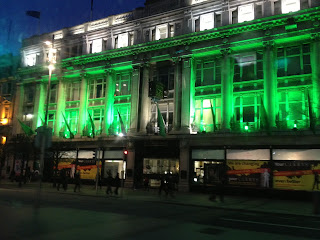On April 24, 1916, the Irish Brotherhood published the
Proclamation of the Republic declaring “To the people of Ireland: Irishmen And
Irishwomen: In the name of God and of the dead generations from which she
receives her old tradition of nationhood, Ireland, through us, summons her
children to her flag and strikes for her freedom.”[ii] The
Proclamation was similar to a document, the Declaration of Independence,
written 140 years earlier to create an independent government for the United
States. In both instances, men of conviction signed a document, the 1916
Proclamation of the Republic and the 1776 Declaration of Independence, to effectively
create an independent government separate from the British rule. By signing the
document, they wanted to create a better life for their countrymen through
self-governance. Additionally, by signing the document, all of the men signed
their death warrants for standing in defiance of the Crown.
This is where the similarities end: the Easter Rising of
1916 ended very differently than the American Revolution of 1776. The British squashed
the Easter Rising in 6 days. The seven authors of the Proclamation were
executed within 19 days of the beginning of the Easter Rising. Six of the
authors, Thomas J. Clarke, Seán Mac Diarmada, Thomas MacDonagh, P. H. Pearse,
Éamonn Ceannt, and Joseph Plunkett, were stood against the stone walls of the
Kilmainham Gaol courtyard and shot. The seventh author, James Connolly was shot
on the opposite side of the courtyard while he was tied to a chair due the fact
that he shattered his ankle during the fight.
This could have been the fate of the planners of the
American Revolution and authors of the Declaration of Independence. They lived
to fight the British for 8 years and ultimately win the independence for the
United States of America. It was this point that struck me so strongly. The desire
for self-governance is one that resonates within us all. It is this desire
motivates our leaders to make great sacrifices in the name of the greater good
for their countrymen and women.
by Ammy George
[i] Kilmainham Gaol Courtyard. Photo by http://snowbirdjournal.com/upload/2481/july2012/Courtyard_at_Kilmainham_Goal.jpg
[ii] Primary Documents - Proclamation of the Irish Republic, 24 April 1916. http://www.firstworldwar.com/source/irishproclamation1916.htm













